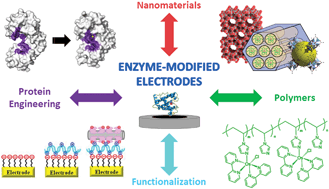Enzyme-modified electrodes for biosensors and biofuel cells
Abstract
In biosensors and biofuel cells, it is often desirable to accelerate the electron transfer rate between the enzyme and electrode surface to improve the performance of the devices (sensitivity or power output). To this end, in this review, we focus on three important strategies available to improve the performance of enzyme-modified electrodes: the use of protein engineering, designer polymers, and the introduction of nanomaterials. Engineering the protein or proteins that constitute the biocatalytic elements allow tuning their stability, activity, and specificity. It can also allow changing the enzyme immobilization efficiency (adsorption vs. covalent immobilization, for example). If direct electron transfer is not favorable, it may be possible to introduce polymers in the system that mediate the electron transfer to or from the electrode surface. Significant advances have recently been made on the design of polymers to modify electrodes, including molecularly imprinted polymers and responsive polymers. A third element that can be incorporated into electrodes is nanoparticles. These nanomaterials can act as scaffolds to immobilize the biocatalytic elements through adsorption or chemical reaction with functional groups, increasing the surface area and the robustness of the electrode. A wealth of nanomaterials is being tested as part of novel enzyme-modified electrode designs, including graphene, carbon nanotubes, metallic nanoparticles, silicas, and metal–organic frameworks. Some of these can also be designed as nanowires to enable or shorten the direct electron transfer from distal active sites in the enzymes. In addition to these strategies, we also highlight selected applications of enzyme-modified electrodes, including glucose biosensing, self-powered biosensors, and self-charging biosupercapacitors. We conclude the review with a reflection on novel approaches, applications, and challenges that we foresee can impact how to design the enzyme-modified electrodes of tomorrow.

- This article is part of the themed collection: Horizons Community Board Collection: Biosensors


 Please wait while we load your content...
Please wait while we load your content...